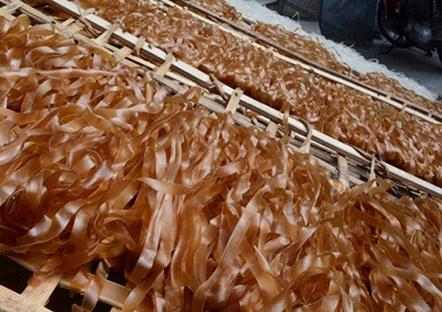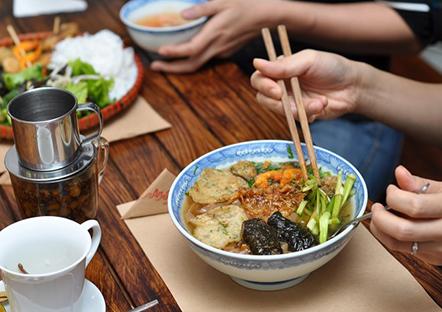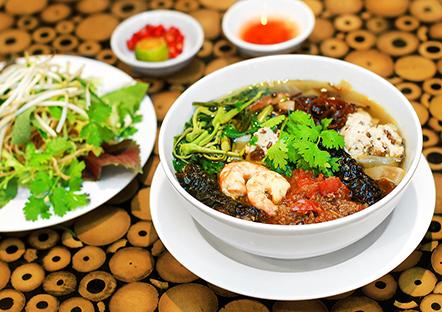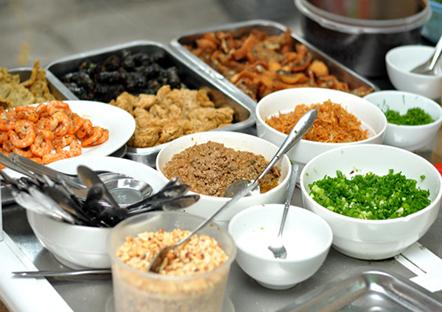Returning to Hai Phong to have a bowl of canh banh da Dearly missing Cat Dai Waiting for Cat Cut When poet Nguyen Thuy Kha, a Hai Phong native, penned these verses, he was speaking for all the people of the port city who never fail to get nostalgic for this particular dish when they are away from home.

Hai Phong has three villages with a 700-year history of making banh da. Hai Phong’s banh da strip is wider than the normal noodle and is either white or dark brown
The canh banh da that the poet wrote about is a noodle soup, but the noodles are very different from what is found elsewhere in the country, and the dish’s flavours are particular to the port city, too.
“Hai Phong food is in the middle range: not too sour, spicy, salty or sweet. Hai Phong cooks are not very meticulous in their presentation, like in the royal Hue cuisine, for example; they pay more attention to the freshness of the ingredients, especially seafood and river-food,” said Dao Thi Thanh Mai, a culture and tourism lecturer at a private university in the port town.
“Delicacies of Hai Phong are often associated with seafood and river-food like fish, crab and shrimp. And banh da cua has been the dish that has been attached with the memory of Hai Phong natives for long.”

The dish features banh da (locally-made flat rice noodle), crab meat, pork bones-based broth and vegetables. It is the city’s pride, just as pho is to Hanoians.
If pho represents the delicateness of Ha Noi cooks and food connoiseurs, banh da cua can be said to be an expression and demonstration of traits of people from Hai Phong – sharp, bold and frank.
Banh da cua can be found in any street of the port city and can be had at any time of the day, from dawn to midnight, said Nguyen Hoai Phuong, a resident of the city’s Ngo Quyen Street.
“I still remember the early mornings when I walked to school with my friends or the wintery evenings when I sat in a street-food stall, breathing in the aroma of fried minced dried onions and watching smoke swirl from the broth of banh da cua.
“As far as I am concerned, a Hai Phong woman is one who knows how to cook a bowl of banh da cua. It is easy and always satisfies. A full bowl can have moc (pork ball) or cha la lot (fried minced pork wrapped in la lot leaves), or cha ca (fried minced fish). But to keep it simple, they just need to put the brown noodle in broth with crab meat,” said Phuong.
In the old days, Tam Thuat alley off Cat Dai Street was one of the places that had a large number of banh da cua sellers.
Everyday from 3 to 4am, when the night lights were still on, residents could hear the familiar sound of crab meat being pounded with a mortar and pestle, said Tran Thi Binh, a Hai Phong native.
Some home cooks still use a mortar and pestle instead of using a blender to pound the crabs when making the noodle soup, and they swear by the superior taste it imparts.
Then there are those who will use only the water spinach grown in the Do Son area, which is best known for its crunchy taste.

Banh da cua now is available in different regions of Viet Nam, but natives and many others claim that it is only in Hai Phong that one gets the must authentic taste of this specialty. They say that the locally made rice noodles make a difference, and the difference makes this dish specific to Hai Phong.
Hai Phong has three villages – Lang Con, Ho and Du Hang Kenh – that have a 700-year history of making this noodle.
Hai Phong’s banh da strip, white or dark brown, is wider than the normal noodle, carries a strong fragrance of rice and has a chewy taste. To make banh da cua, Hai Phong people will use fresh banh da, dipping in hot water and then putting it in the broth. Cooks in other regions use dry banh da instead and soak it in cool water for several minutes before putting it in the broth.
Royal approval

No discussion of any crab dish in the country is complete without mentioning the crab broth.
The broth is not particular to any locality, and it has its roots in rural areas, but it has gone from humble beginnings to receive royal approval.
“When I was small, life was very difficult. Those that had corn and sweet potato for their daily meal were considered wealthy. Most families experienced hunger, and meat was an unaffordable luxury. My friends and I would go often to the rice fields and catch crabs to supplement our meager meals,” said Nguyen Van Thanh of Nam Dinh Province.
“Being away from my rural hometown for a long time, crab broth is the thing that I always miss the most. For me, it is linked to my childhood, my mother, the best cook, and the countryside,” Thanh said.
It is said that King Le Hien Tong (1461-1504) once visited his master teacher, Nguyen Bao, in Chau Khe Village, Hai Duong Province. The teacher invited his royal student to have a meal with him. It was simple fare with crab broth made in a rural kitchen, something that could not be found in the palace. The king told his teacher the crab broth was more tasty than any other dish.

Later, the king missed the broth, and locals began offering crabs to the royal palace. Since then, there is a folk saying that goes:
Canh cua nau cai them gung
Xua nay vua chua da tung khen ngon
or
Crab broth cooked with canola and ginger
Has for long been praised by the king.
These days, even after considerable improvements in living standards, crab broth remains a favourite for many. It is cooked with many different vegetables including rau ngot (star gooseberry), rau cai (canola), bau (gourd) or hoa thien ly (cowslip creeper flowers).


